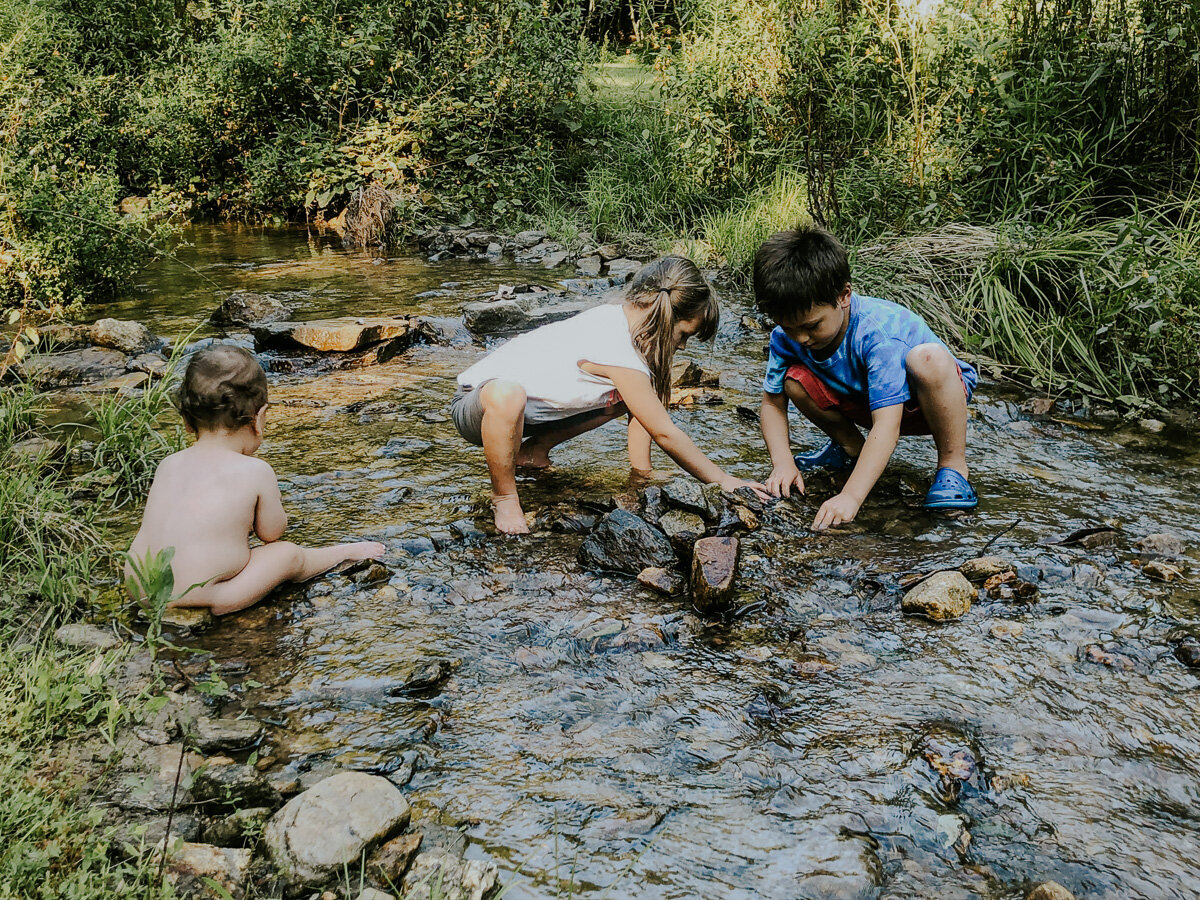Raising a wild child
A is for acorn, B is for bluebell, C is for clover.
My daughter is holding in her hands a "spellbook of lost words." The Lost Words by Robert Macfarlane and Jackie Morris captures this moment in time when we're rapidly losing not only knowledge about the natural world, but even the language with which we can talk about it.
Here's why this book exists: In 2007, the editors at Oxford Junior Dictionary dropped 50 nature-related words from this children's dictionary as “culturally irrelevant.” ‘Acorn,’ ‘buttercup,’ ‘conker,’ ‘chestnut’ and ‘fern’ and 'lark' had to go in order to make space for terms such as ‘broadband’ and ‘cut-and-paste.’ The decision has received a lot of criticism. In 2015, Margaret Atwood and 27 other prominent writers, naturalists, and media personalities wrote an open letter to Oxford University Press, pleading that they reinstate the omitted words. A petition on Change.org drew over 214,000 signatures.
Nature Play and Children's Well-Being
Studies show pretty unquestionably that decline in nature play correlates with a decline in children’s well-being. A 2009 study by Natural England showed that a generation ago, 40% of children regularly played in wild places; now its fewer than 10%. 40% of children never play outdoors. According to some studies, kids spend on average 6-7 hours a day in front of gadgets. Children can name more Pokémon characters than wildlife species.
The numbers are hardly better for the U.S. or many other affluent countries. The heartbreakingly-titled Last Child in the Woods by Richard Louv brings together a growing body of research on the so-called nature-deficit disorder among children, and its links to the disturbing rise in childhood obesity, attention disorders, and depression.
We know children need to play outside more. We know they are not spending enough time in unsupervised play in natural environments. We know they are becoming increasingly disconnected from the most basic knowledge regarding where food comes from, or how things are made, or how to use simple tools to solve problems.
These facts are not up for debate. The question is: what do we do about it?
Parents, grandparents, and caretakers: it's on us.
Here are 10 things you can do to make nature awareness a daily, ordinary part of a child's life.
#1 Nurture a child's innate curiosity about the natural world
Little kids are instinctively fascinated by nature's processes. Tap into that curiosity and give them space to explore: digging for worms and pill bugs in the backyard, observing squirrels and birds, building log cabins out of sticks and creek dams with rocks. Often, all we as caretakers need to provide is the context, the opportunity. The kids will take it from there.
#2 Lead by example
Children pick up on the grownups' vibes. If you yourself are uncomfortable or distracted in nature — not having a good time and instead compulsively checking your newsfeed — you are wordlessly communicating to a child that the natural world is not fun or worthy of our attention. So reflect on your own relationship to nature, and commit to working on whatever it is that makes you unable or unwilling to relax or get adventurous in it. Probably your best teachers in this will be kids themselves.
#3 Plant a garden
One of the best ways to learn about nature's cycles is to get one's hands in the dirt and participate in them. Involve kids in all stages of gardening: preparing the soil, planting seeds, watering, weeding, and harvesting. Give them a little patch of their own to tend. If you have no garden space, a windowsill or balcony container garden works great. Over time, they start to "get it": they learn to make the connection between soil and sunlight and water on the one hand, and food on our plates, on the other. Gardening also encourages kids to eat fresh produce: often a picky eater who won't eat vegetables at the dinner table loves to pick snap peas or cherry tomatoes straight off the vine.
#4 Make it relevant
Let's forget about the Oxford Junior Dictionary: What words get used in your home? Does your language reflect an appreciation for the rich variety of life-forms and elements that make up the natural world?
I can say with some certainty that my daughter is not likely to lose the meaning of "acorn" as long as we forage acorns together or have acorn pancakes for breakfast on Sundays. Nor will "otter" disappear from her vocabulary as long as we make regular visits to the WNC Nature Center, where the two otters swimming in their tank is her favorite highlight. She won't forget the meaning of "hawk" as long as she has the large hawk feather in her treasure basket, along with her rock and sea shell collection, that she will proudly pull out to show visitors.
#5 Look into forest and outdoor educational programs
Forest kindergartens, wilderness summer camps and other kids' nature programs are a wonderful thing if you can take advantage of them. Through outdoor play, children develop their motor skills, engage in creative play, learn to use their five senses, and start to cultivate a lifelong relationship with nature and wildlife. Learn more about forest schools here.
#6 Make outdoor play as inviting as possible
Make the outdoor spaces around your home at least as exciting as the (increasingly addictive and techno-focused) indoor activities. If there's nothing for them outside except a drab lawn or landscaping they aren't allowed to touch, no wonder kids don't want to go outside. Install a rope swing. Set up a sandbox or other area where kids can simply play with soil and rocks. Stop worrying and let them climb trees. Provide really fun outdoor toys (they don't have to be expensive: think frisbees or balls). Get them biking in the park. True, it's not true wilderness exposure if you live in urban or suburban areas. But just getting kids to play outside, breathing fresh air, being physically active, is infinitely better than no outdoor time at all. You're still giving them opportunities for engagement with the natural world.
#7 Just dress them properly
Rain gear. Snow gear. Running-under-the-sprinkler gear. You get the point. I grew up playing and walking to school in –30 Celsius weather. It was fine — I simply had warm clothes on. To quote my fellow Nordic mom Linda Åkerson McGurk, "There's No Such Thing as Bad Weather" — only inadequate gear.
#8 Dirt is okay
The modern dirt phobia, the overuse of sanitizers and antibacterials, actually weakens our bodies’ own defense systems. Asthma and allergy are lower in farming communities than in urban areas because children who grow up on farms get exposed to a diversity of bacterial species through their interaction with farm animals and farm dirt. These very bacterial and fungal organisms promote a healthy immunological response.
As Maya Sherat-Klein writes in The Dirt Cure,
"It turns out that all the things that are messy and dirty in the world, the very things we thought we needed to control or even eliminate to stay alive, are actually the very elements necessary for robust health. Research says that bacteria, fungi, parasites, insects, weeds — and living, nutrient-dense soil full of all of those elements — play direct and critical roles in the health of our food, and by extension, the health of our children."
And those muddy clothes can be thrown in the washer afterwards. Let kids get dirty.
#9 Schedule nature time...
...as something that you do together as a family. Unless you live in a rural area, in the modern world it takes a bit of a commitment to spend time regularly in nature. So plan family activities so that they include that regular dose of "forest bathing." For our family, a weekend forest hike is a weekly tradition. We meet with friends to go play in the woods or wade by the creek. And in part because of our commitment to eating as locally as possible, we make frequent visits to local farms, orchards, and foraging spots.
#10 Read nature-related books together
Head to the library and explore together age-appropriate books on nature. I don't know any young child that isn't interested in animals. Let them lead and pick books on subjects they find most fascinating: is it cute puffins or koalas, or dinosaurs, or volcanoes, or slimy sea creatures? It doesn't matter what the content is: what matters is that you sit down and read together and talk about what you learn. Again, in doing so, the grownup is affirming the child's sense that this is interesting and worthwhile to learn about.
That's my two cents. Now I'd love to hear from you: What other strategies do you have in your tool belt? What have you found helpful in raising kids to be comfortable in the natural world and engaged in it?





